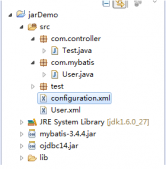前置通知[before advice]:在连接点前面执行,前置通知不会影响连接点的执行,除非此处抛出异常。
正常返回通知[after returning advice]:在连接点正常执行完成后执行,如果连接点抛出异常,则不会执行。
异常返回通知[after throwing advice]:在连接点抛出异常后执行。
返回通知[after (finally) advice]:在连接点执行完成后执行,不管是正常执行完成,还是抛出异常,都会执行返回通知中的内容。
环绕通知[around advice]:环绕通知围绕在连接点前后,比如一个方法调用的前后。这是最强大的通知类型,能在方法调用前后自定义一些操作。
环绕通知还需要负责决定是继续处理join point(调用proceedingjoinpoint的proceed方法)还是中断执行。
接下来通过编写示例程序来测试一下五种通知类型:
定义接口
|
1
2
3
4
5
6
7
8
9
10
11
12
13
|
package com.chenqa.springaop.example.service;public interface bankservice { /** * 模拟的银行转账 * @param from 出账人 * @param to 入账人 * @param account 转账金额 * @return */ public boolean transfer(string form, string to, double account);} |
编写实现类
|
1
2
3
4
5
6
7
8
9
10
11
12
13
14
15
|
package com.chenqa.springaop.example.service.impl;import com.chenqa.springaop.example.service.bankservice;public class bcmbankserviceimpl implements bankservice { public boolean transfer(string form, string to, double account) { if(account<100) { throw new illegalargumentexception("最低转账金额不能低于100元"); } system.out.println(form+"向"+to+"交行账户转账"+account+"元"); return false; }} |
修改spring配置文件,添加以下内容:
|
1
2
3
4
5
6
7
8
9
10
11
12
13
14
15
|
<!-- bankservice bean --> <bean id="bankservice" class="com.chenqa.springaop.example.service.impl.bcmbankserviceimpl"/> <!-- 切面 --> <bean id="myaspect" class="com.chenqa.springaop.example.aspect.myaspect"/> <!-- aop配置 --> <aop:config> <aop:aspect ref="myaspect"> <aop:pointcut expression="execution(* com.chenqa.springaop.example.service.impl.*.*(..))" id="pointcut"/> <aop:before method="before" pointcut-ref="pointcut"/> <aop:after method="after" pointcut-ref="pointcut"/> <aop:after-returning method="afterreturning" pointcut-ref="pointcut"/> <aop:after-throwing method="afterthrowing" pointcut-ref="pointcut"/> <aop:around method="around" pointcut-ref="pointcut"/> </aop:aspect> </aop:config> |
编写测试程序
|
1
2
3
|
applicationcontext context = new classpathxmlapplicationcontext("spring-aop.xml"); bankservice bankservice = context.getbean("bankservice", bankservice.class); bankservice.transfer("张三", "李四", 200); |
执行后输出:
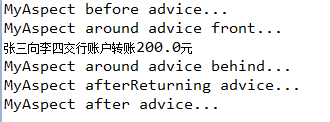
将测试程序中的200改成50,再执行后输出:
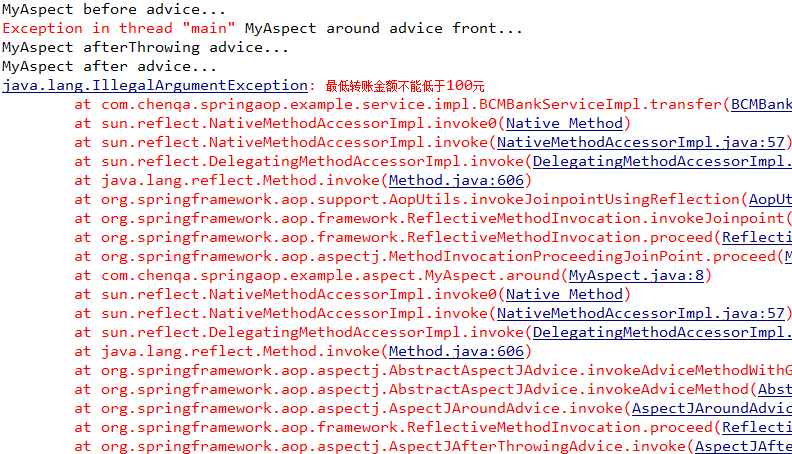
通过测试结果可以看出,五种通知的执行顺序为:
前置通知→环绕通知→正常返回通知/异常返回通知→返回通知,可以多次执行来查看。
情况一: 一个方法只被一个aspect类拦截
当一个方法只被一个aspect拦截时,这个aspect中的不同advice是按照怎样的顺序进行执行的呢?请看:
添加 pointcut类
该pointcut用来拦截test包下的所有类中的所有方法。
|
1
2
3
4
5
6
7
8
9
10
|
package test;import org.aspectj.lang.annotation.pointcut;public class pointcuts { @pointcut(value = "within(test.*)") public void aopdemo() { }} |
添加aspect类
该类中的advice将会用到上面的pointcut,使用方法请看各个advice的value属性。
|
1
2
3
4
5
6
7
8
9
10
11
12
13
14
15
16
17
18
19
20
21
22
23
24
25
26
27
28
29
30
31
32
33
34
35
36
37
38
|
package test;import org.aspectj.lang.joinpoint;import org.aspectj.lang.proceedingjoinpoint;import org.aspectj.lang.annotation.*;import org.springframework.stereotype.component;@component@aspectpublic class aspect1 { @before(value = "test.pointcuts.aopdemo()") public void before(joinpoint joinpoint) { system.out.println("[aspect1] before advise"); } @around(value = "test.pointcuts.aopdemo()") public void around(proceedingjoinpoint pjp) throws throwable{ system.out.println("[aspect1] around advise 1"); pjp.proceed(); system.out.println("[aspect1] around advise2"); } @afterreturning(value = "test.pointcuts.aopdemo()") public void afterreturning(joinpoint joinpoint) { system.out.println("[aspect1] afterreturning advise"); } @afterthrowing(value = "test.pointcuts.aopdemo()") public void afterthrowing(joinpoint joinpoint) { system.out.println("[aspect1] afterthrowing advise"); } @after(value = "test.pointcuts.aopdemo()") public void after(joinpoint joinpoint) { system.out.println("[aspect1] after advise"); }} |
添加测试用controller
添加一个用于测试的controller,这个controller中只有一个方法,但是它会根据参数值的不同,会作出不同的处理:一种是正常返回一个对象,一种是抛出异常(因为我们要测试@afterthrowing这个advice)
|
1
2
3
4
5
6
7
8
9
10
11
12
13
14
15
16
17
18
19
20
21
22
23
24
25
26
27
28
29
30
31
32
33
34
35
36
37
38
39
40
41
42
43
44
45
46
47
48
|
package test;import test.exception.testexception;import org.springframework.http.httpstatus;import org.springframework.web.bind.annotation.*;@restcontroller@requestmapping(value = "/aop")public class aoptestcontroller { @responsestatus(httpstatus.ok) @requestmapping(value = "/test", method = requestmethod.get) public result test(@requestparam boolean throwexception) { // case 1 if (throwexception) { system.out.println("throw an exception"); throw new testexception("mock a server exception"); } // case 2 system.out.println("test ok"); return new result() {{ this.setid(111); this.setname("mock a result"); }}; } public static class result { private int id; private string name; public int getid() { return id; } public void setid(int id) { this.id = id; } public string getname() { return name; } public void setname(string name) { this.name = name; } }} |
测试 正常情况
在浏览器直接输入以下的url,回车:http://192.168.142.8:7070/aoptest/v1/aop/test?throwexception=false1
我们会看到输出的结果是:
|
1
2
3
4
5
6
|
[aspect1] around advise 1[aspect1] before advisetest ok[aspect1] around advise2[aspect1] after advise[aspect1] afterreturning advise |
测试 异常情况
在浏览器中直接输入以下的url,回车:http://192.168.142.8:7070/aoptest/v1/aop/test?throwexception=true1
我们会看到输出的结果是:
|
1
2
3
4
5
|
[aspect1] around advise 1[aspect1] before advisethrow an exception[aspect1] after advise[aspect1] afterthrowing advise |
结论
在一个方法只被一个aspect类拦截时,aspect类内部的 advice 将按照以下的顺序进行执行:
正常情况:
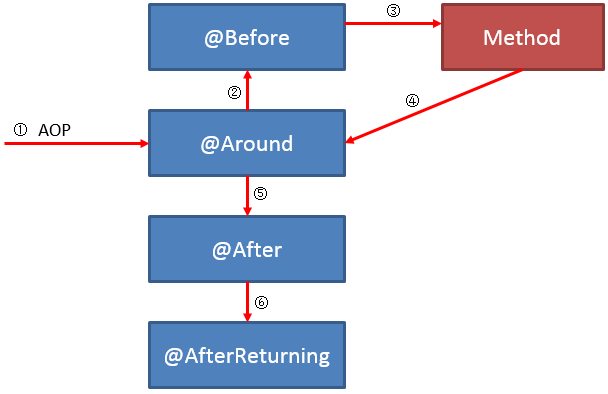
异常情况:
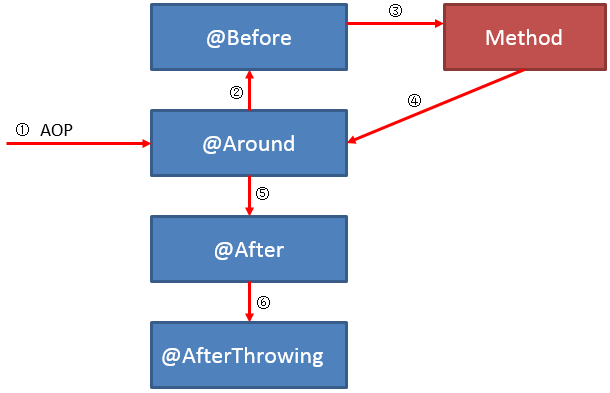
情况二: 同一个方法被多个aspect类拦截
此处举例为被两个aspect类拦截。
有些情况下,对于两个不同的aspect类,不管它们的advice使用的是同一个pointcut,还是不同的pointcut,都有可能导致同一个方法被多个aspect类拦截。那么,在这种情况下,这多个aspect类中的advice又是按照怎样的顺序进行执行的呢?请看:
pointcut类保持不变
添加一个新的aspect类
|
1
2
3
4
5
6
7
8
9
10
11
12
13
14
15
16
17
18
19
20
21
22
23
24
25
26
27
28
29
30
31
32
33
34
35
36
37
38
|
package test;import org.aspectj.lang.joinpoint;import org.aspectj.lang.proceedingjoinpoint;import org.aspectj.lang.annotation.*;import org.springframework.stereotype.component;@component@aspectpublic class aspect2 { @before(value = "test.pointcuts.aopdemo()") public void before(joinpoint joinpoint) { system.out.println("[aspect2] before advise"); } @around(value = "test.pointcuts.aopdemo()") public void around(proceedingjoinpoint pjp) throws throwable{ system.out.println("[aspect2] around advise 1"); pjp.proceed(); system.out.println("[aspect2] around advise2"); } @afterreturning(value = "test.pointcuts.aopdemo()") public void afterreturning(joinpoint joinpoint) { system.out.println("[aspect2] afterreturning advise"); } @afterthrowing(value = "test.pointcuts.aopdemo()") public void afterthrowing(joinpoint joinpoint) { system.out.println("[aspect2] afterthrowing advise"); } @after(value = "test.pointcuts.aopdemo()") public void after(joinpoint joinpoint) { system.out.println("[aspect2] after advise"); }} |
测试用controller也不变
还是使用上面的那个controller。但是现在 aspect1 和 aspect2 都会拦截该controller中的方法。
下面继续进行测试!
测试 正常情况
在浏览器直接输入以下的url,回车:http://192.168.142.8:7070/aoptest/v1/aop/test?throwexception=false1
我们会看到输出的结果是:
|
1
2
3
4
5
6
7
8
9
10
11
|
[aspect2] around advise 1[aspect2] before advise[aspect1] around advise 1[aspect1] before advisetest ok[aspect1] around advise2[aspect1] after advise[aspect1] afterreturning advise[aspect2] around advise2[aspect2] after advise[aspect2] afterreturning advise |
但是这个时候,我不能下定论说 aspect2 肯定就比 aspect1 先执行。
不信?你把服务务器重新启动一下,再试试,说不定你就会看到如下的执行结果:
|
1
2
3
4
5
6
7
8
9
10
11
|
[aspect1] around advise 1[aspect1] before advise[aspect2] around advise 1[aspect2] before advisetest ok[aspect2] around advise2[aspect2] after advise[aspect2] afterreturning advise[aspect1] around advise2[aspect1] after advise[aspect1] afterreturning advise |
也就是说,这种情况下, aspect1 和 aspect2 的执行顺序是未知的。那怎么解决呢?不急,下面会给出解决方案。
测试 异常情况
在浏览器中直接输入以下的url,回车:http://192.168.142.8:7070/aoptest/v1/aop/test?throwexception=true1
我们会看到输出的结果是:
|
1
2
3
4
5
6
7
8
9
|
[aspect2] around advise 1[aspect2] before advise[aspect1] around advise 1[aspect1] before advisethrow an exception[aspect1] after advise[aspect1] afterthrowing advise[aspect2] after advise[aspect2] afterthrowing advise |
同样地,如果把服务器重启,然后再测试的话,就可能会看到如下的结果:
|
1
2
3
4
5
6
7
8
9
|
[aspect1] around advise 1[aspect1] before advise[aspect2] around advise 1[aspect2] before advisethrow an exception[aspect2] after advise[aspect2] afterthrowing advise[aspect1] after advise[aspect1] afterthrowing advise |
也就是说,同样地,异常情况下, aspect1 和 aspect2 的执行顺序也是未定的。
那么在 情况二 下,如何指定每个 aspect 的执行顺序呢?
方法有两种:
- 实现org.springframework.core.ordered接口,实现它的getorder()方法
- 给aspect添加@order注解,该注解全称为:org.springframework.core.annotation.order
不管采用上面的哪种方法,都是值越小的 aspect 越先执行。
比如,我们为 apsect1 和 aspect2 分别添加 @order 注解,如下:
|
1
2
3
4
5
6
7
8
9
10
11
12
13
|
@order(5)@component@aspectpublic class aspect1 { // ...}@order(6)@component@aspectpublic class aspect2 { // ...} |
这样修改之后,可保证不管在任何情况下, aspect1 中的 advice 总是比 aspect2 中的 advice 先执行。如下图所示:
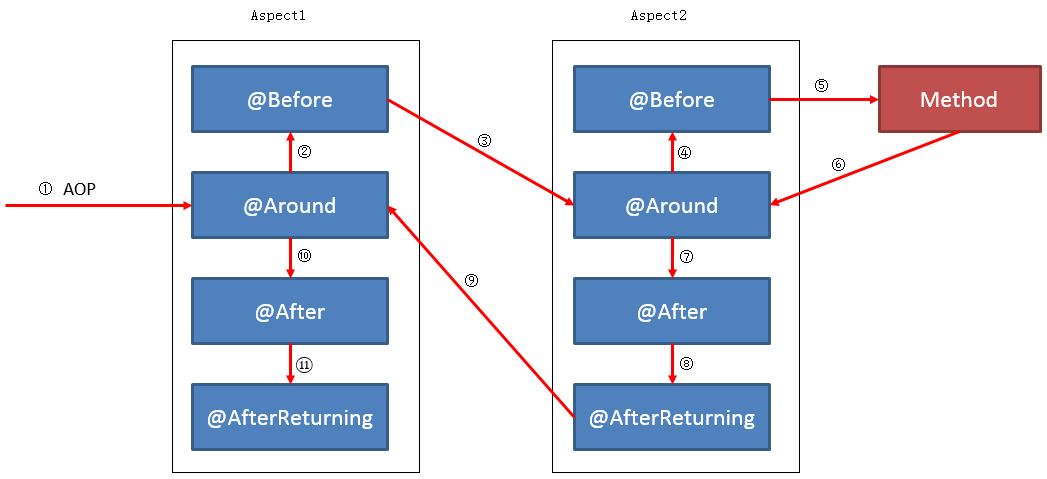
注意点
如果在同一个 aspect 类中,针对同一个 pointcut,定义了两个相同的 advice(比如,定义了两个 @before),那么这两个 advice 的执行顺序是无法确定的,哪怕你给这两个 advice 添加了 @order 这个注解,也不行。这点切记。
对于@around这个advice,不管它有没有返回值,但是必须要方法内部,调用一下 pjp.proceed();否则,controller 中的接口将没有机会被执行,从而也导致了 @before这个advice不会被触发。比如,我们假设正常情况下,执行顺序为”aspect2 -> apsect1 -> controller”,如果,我们把 aspect1中的@around中的 pjp.proceed();给删掉,那么,我们看到的输出结果将是:
|
1
2
3
4
5
6
7
8
9
|
[aspect2] around advise 1[aspect2] before advise[aspect1] around advise 1[aspect1] around advise2[aspect1] after advise[aspect1] afterreturning advise[aspect2] around advise2[aspect2] after advise[aspect2] afterreturning advise |
从结果可以发现, controller 中的 接口 未被执行,aspect1 中的 @before advice 也未被执行。
以上就是本文的全部内容,希望对大家的学习有所帮助,也希望大家多多支持服务器之家。
原文链接:http://blog.csdn.net/qq_35873847/article/details/78624941



